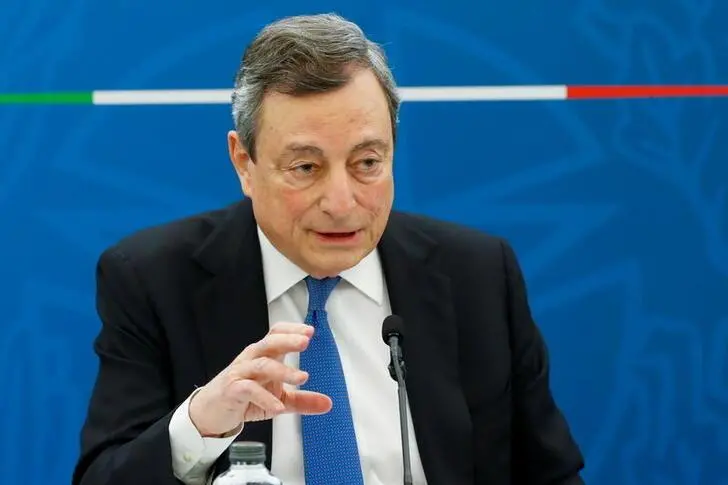PHOTO
(The author is a Reuters Breakingviews columnist. The opinions expressed are her own.)
MILAN - Italy’s surprisingly robust economic recovery faces a trio of challenges: the relaxation of a ban on layoffs, the end of interest-rate holidays on loans, and high indebtedness. Fortunately for the euro zone’s third biggest economy, the European Central Bank’s asset purchases will keep a firm lid on borrowing costs for bit longer. That buys Prime Minister Mario Draghi time to perform a major service for his country.
After a devastating 9% contraction last year, the economy is showing multiple signs of strength. For example, the service sector grew at the fastest rate since 2018 in June after restrictions on activity were lifted and the national statistics office says around 45,000 new jobs were added on average each month between February and May. Such statistics are prompting upgrades to growth forecasts. Economy Minister Daniele Franco said on Tuesday that Italian GDP may expand by 5% or more this year, higher than the government’s April prediction of 4.5%.
It won’t be plain sailing. The parliamentary budget office reckons 130,000 jobs might be at risk after the relaxation of a ban on layoffs in July. And loan defaults by households and businesses could surpass 10% of total Italian bank loans once interest payment holidays are removed in December, says Fitch. That would be double December 2020 levels, according to research company CEIC data. Meanwhile, the European Commission expects public debt will rise to 160% of GDP this year.
Luckily, the ECB will keep monetary policy ultra-loose until the euro zone economy is fully back on its feet. The average interest rate on newly issued Italian public debt fell to just 0.11% in March from 1.07% in 2018, Treasury figures show. This creates an opportunity for Draghi. True, his government of national unity cannot last beyond mid-2023 and that’s not long enough to fully modernise Italy through reforms. But he is likely to still be in charge when EU member states next year rewrite the bloc’s fiscal rules. The former ECB boss could push for a pact that would allow more leeway for spending in growth-enhancing areas such as infrastructures, education and research. Securing such changes in the face of German or Dutch opposition might end up as his biggest contribution to the country’s economy.
CONTEXT NEWS
- The IHS Markit Purchasing Managers’ Index for Italy rose to 62.3 in May, the highest level since the survey began in June 1997, from 60.7 in April, a survey showed on June 1.
-IHS Markit's Business Activity Index for services showed on July 5 that the sector grew at its fastest rate since 2018 in June.
- Italy's economy may grow by 5% or more in 2021, Economy Minister Daniele Franco said on July 6. That compares with the government’s April forecast that GDP would rise 4.5% in 2021 after contracting 8.9% in 2020.
- The European Commission said in its spring economic forecasts in May that it expected Italy’s debt to rise to 160% of gross domestic product in 2021.
(The author is a Reuters Breakingviews columnist. The opinions expressed are her own.)
(Editing by Swaha Pattanaik and Sharon Lam) ((SIGN UP FOR BREAKINGVIEWS EMAIL ALERTS http://bit.ly/BVsubscribe | lisa.jucca@thomsonreuters.com ; Reuters Messaging: lisa.jucca.thomsonreuters.com@reuters.net))












